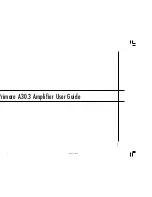
UHF Amplifier AMP1-10
AMPUSE/4
1
07/05
UHF Power Amplifier Model AMP1-10 MK2
Overview
This amplifier is designed to increase the operating range of an already correctly
installed system. In such a system the need for a well sited transmitting aerial
should previously have been addressed. The amplifier is not intended as a
substitute for an indifferent, poorly located aerial. In this context, we would strongly
advise not to connect a simple quarter wave antenna directly to the ‘N’ type output
connector, as this will inevitably produce a strong local radiated field, which is quite
capable of causing interference to other equipment in the vicinity.
Note ! This system requires a valid OFCOM licence for operation in the UK. It is the
user’s responsibility to apply for an On-Site Paging licence on form Of21 Private
Business Radio Licence Application Form, available online at www.ofcom.org.uk
The relevant clauses on the Of21 form should be completed as follows:
Section 2, item 9. Tick “
Self-Select PBR licence
”
Section 4, item 28. Generally, antennas provided by Scope are
Omni-Directional
,
with a gain of
0 dB.
Section 4, item 30. ERP level:
0.5W
as standard,
2W
if the amplifier is fitted.
Warning! Alteration or modification to any part of this equipment, including operation
without a suitable antenna, will invalidate all Approvals and Warranties attaching to
the equipment. Further liability for the operation of the equipment, under the
applicable law, will pass to the user, who will absolve the manufacturer of any further
responsibility for it’s correct operation and use.
Installation
The output from the amplifier should be fed, via good quality coaxial cable, to a
dipole or beam aerial mounted high on a mast and clear of local obstructions. A
minimum cable specification is RG213 or UR67, and for runs longer than ten metres,
helical membrane (Heliax) cables are worth considering. At high frequencies, poor
quality cable and associated plugs and sockets incur high losses, and quickly negate
the theoretical improvements in system performance which a power amplifier might
otherwise bring.
The following example is presented as an illustration of potential system losses. At
460 MHz standard RG213 or UR67 cable loses 1 decibel - approximately 20% - of
the incident power for every 5 metres of length, and 15 metres (50 feet) loses 3dB.
This means that if you start with 10 watts out of the amplifier, you will get only 5
watts at the far end of 15 metres of RG213 cable! These loss figures apply only to
cable in a new, dry condition. Note that word dry, because once moisture is allowed
to enter the ends of the cable it will corrode the copper conductors, particularly the
outer braid, and thereby raise the loss to the point where the cable looks like a
reasonable dummy load, soaking up most of the transmitter power. It follows that
only good quality watertight, ‘O’ ring sealed connectors should be used. Unsealed
crimped connectors are a false economy and will result in the system failing in the
longer term.






















